| Srl | Item |
| 1 |
ID:
138289
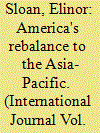

|
|
|
|
|
| Summary/Abstract |
This paper examines the impact of the US pivot to the Asia-Pacific on Canada’s strategic thinking and maritime posture. It highlights elements of the US rebalance before examining Canada’s recent past, present, and future strategic and military engagement. Canada wants to be able to contribute to crisis de-escalation if regional tensions lead to conflict, yet the Royal Canadian Navy has less deployment capacity today than it has had in 25 years. To contribute to mediatory influence, and provide warfighting capability, a recapitalized navy should increase deployments to the region, forward deploy some naval assets, and ensure interoperability with its US counterpart. In the event of a crisis, a choice might have to be made between a neutral, honest-broker stance and a more likely decision to contribute forces to a US-led coalition. The first step in either case is to be in the Asia-Pacific region with capable and credible naval forces.
|
|
|
|
|
|
|
|
|
|
|
|
|
|
|
|
| 2 |
ID:
056432


|
|
|
| 3 |
ID:
179854
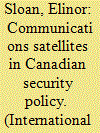

|
|
|
|
|
| Summary/Abstract |
This article traces Canada’s early interest in space, before turning to its late 1960s decision to focus on a domestic, commercial/civilian communications satellite system in geostationary orbit and the subsequent decline in Canada’s military space efforts. It then highlights the wake-up call of the 1991 Gulf War, which demonstrated the critical importance of military communications satellites to future operations, and the steps Canada has taken to gain assured access to such satellites in the decades since. The final section outlines recent advances in low Earth orbit satellite communications (LEO satcom) and the ways in which these systems can address shortfalls in their geostationary cousins. Drawing reference to a new international security environment, it concludes that Canada should move expeditiously to incorporate LEO satcom into efforts to address the growing imperative of military satellite communications in the Canadian Arctic.
|
|
|
|
|
|
|
|
|
|
|
|
|
|
|
|
| 4 |
ID:
088743
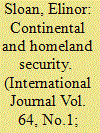

|
|
|
| 5 |
ID:
089712
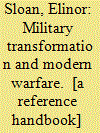

|
|
|
|
|
| Publication |
Westport, Praeger Security International, 2008.
|
| Description |
viii, 183p.
|
| Standard Number |
9780275994051
|
|
|
|
|
|
|
|
|
|
|
|
Copies: C:1/I:0,R:0,Q:0
Circulation
| Accession# | Call# | Current Location | Status | Policy | Location |
| 054256 | 355.3/SLO 054256 | Main | On Shelf | General | |
|
|
|
|
| 6 |
ID:
141120
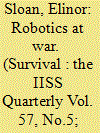

|
|
|
|
|
| Summary/Abstract |
The current United States administration’s use of armed drones to target terrorists in places like Pakistan and Yemen is only the most visible move towards the use of robotics in war. Remote-controlled aerial-surveillance technology dates back to at least the mid-1990s, when the well-known Predator unmanned aerial vehicle (UAV) was deployed in the Balkan wars. But unmanned combat did not appear until the Predator was outfitted with precision missiles in early 2001, making its combat debut that autumn in Afghanistan. Since then, and especially after remote-controlled systems specifically designed for the use of deadly force started to be fielded, ethical issues have been raised about the use of force by operators thousands of miles from harm’s way. Still, with each platform tethered to at least one human who made the fire decision, debate remained relatively subdued.
|
|
|
|
|
|
|
|
|
|
|
|
|
|
|
|